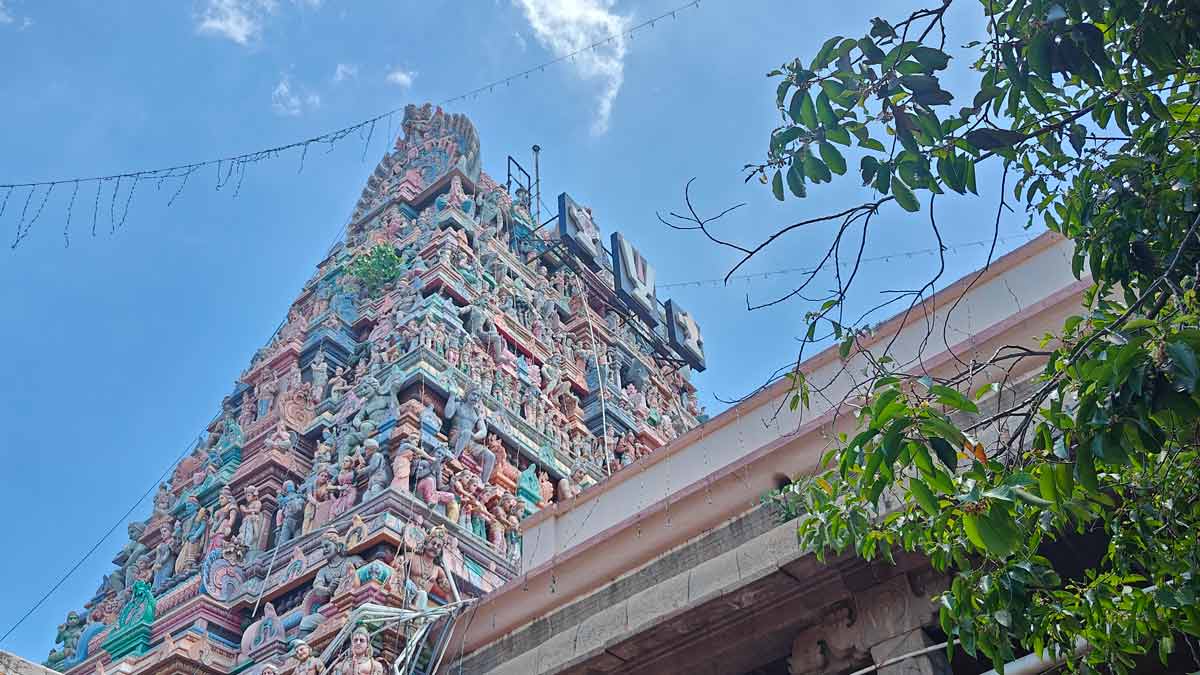Spiritual sojourn in Chennai
 The facade of Parthasarathy Temple | Bindu Gopal Rao
The facade of Parthasarathy Temple | Bindu Gopal Rao
On a recent visit to Chennai, I went temple hopping to discover the spiritual side of the Southern metro that is a mix of culture, architecture, and spirituality.
“There will be some crowds being Saturday today at the Parthasarathy Temple,” my driver Charan tells me. I am headed to Triplicane, one of Chennai’s oldest neighbourhoods, to the temple that is dedicated to Lord Vishnu and dates to the sixth century. The majestic temple spire is what catches my attention and the buzz around with vendors selling all kinds of colourful flowers.
Walking into the temple that was built by the Pallava dynasty, the detailed carvings on the pillars that lead me to the entrance have me enamoured. There is no photography allowed inside the temple, but the main deity here has a moustache, which is quite unusual. Interestingly, the entrance gate has a stone letter dated August 20, 1893, from Swami Vivekananda that he sent to Alasinga Perumal of Triplicane praising Lord Parthasarathy.
With much to think about, I headed to my next stop, driving through Marina Beach, and observing the huge street art murals by A-KILL on the labour dynamics of the city. “This is where you can see the fishermen community and how they work,” points out Charan. And the mural itself showing the fisherwomen mending their nets is an indication of their dependence on the sea. My next stop is at Kapaleeshwarar Temple where the presiding deity is Lord Shiva that was built in the seventh century. Entering the temple through the imposing 37-metre-high tower, that has several beautiful, mythological figures, I admire the intricately carved stone pillars here.
It is interesting to note that local legend has it that this was where Lord Shiva came after taking a holy dip in Ramkund (a water tank that still exists behind the temple). While all Shiva temples have an idol of Nandi, this one does not, as Shiva considers Nandi as his guru here having done penance to get rid of his sin of killing a Brahmin. It was Nandi that showed him how he could take a dip to get rid of the sin making Nandi have the identity of a mentor. There is also an idol of Shiva's wife, Parvati, called Karpagambal. Do not miss the bronze carvings of 63 Saivite saints that surround the sanctum here.
With so many sensory memories, I head to Pullman Chennai Anna Salai, my home in Chennai, a new-age modern hotel spread over 5000 square meters with 232 guest rooms. After a long day I head to Mercato, the in-house restaurant inspired by Mediterranean bazaars and Asian street markets, where Chef Chinna whips up a special local meal of podi idlis, paneer with local spices, corn kebabs with a South Indian twist, a special raw mango curry cooked in coconut milk and decadent fresh mango sago dessert.
With a happy tummy I head off again, admiring the traditional buildings as well as ones inspired by art deco, to Mundakaneeyaman Temple, located in the narrow by lanes of Mylapore. The deity here is housed in a hut-like structure and is believed to be powerful by the local community. “All my prayers here have been answered,” Sakshi, a young bride who moved to this locality after her wedding, tells me.
My final pitstop is at the Ashtalakshmi Kovil. Overlooking Elliot's Beach, this temple is dedicated to the goddess Lakshmi and her eight primary forms, the Ashtalakshmi. Close to 50 years old, the temple has four levels and nine separate sanctums housing the different versions of the goddess, each representing a different aspect of wealth. The temple adjoins a beautiful beach where I am in time to catch a beautiful sunset where the sky is painted in hues of orange.
As I turn back and look at the temple spire, I notice a golden hue enveloping the façade, and I cannot help but think that this trip has been a deeply spiritual inward journey. And for the temples I missed, I know I will be back soon.
Rao is a freelance writer and photographer based in Bengaluru.
Tourism